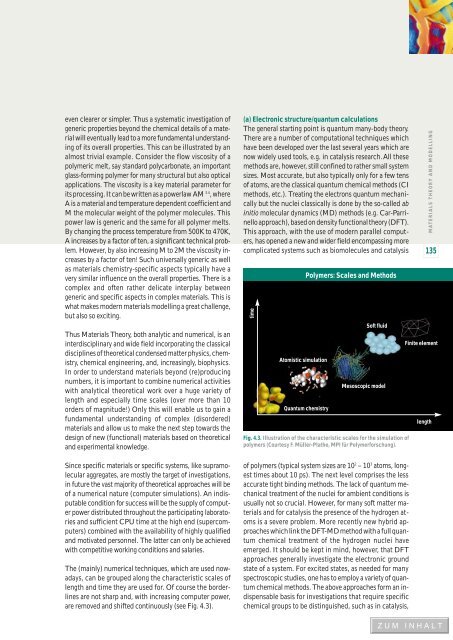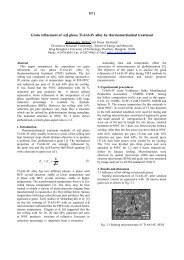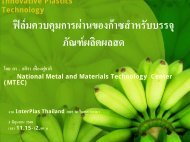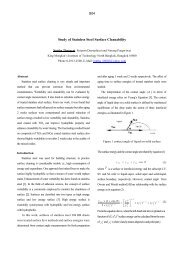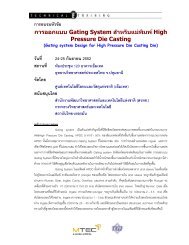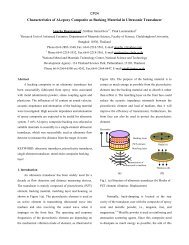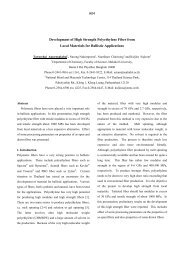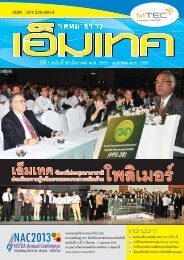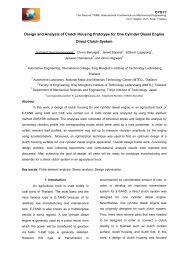EUROPEAN WHITE BOOK
EUROPEAN WHITE BOOK
EUROPEAN WHITE BOOK
You also want an ePaper? Increase the reach of your titles
YUMPU automatically turns print PDFs into web optimized ePapers that Google loves.
even clearer or simpler. Thus a systematic investigation ofgeneric properties beyond the chemical details of a materialwill eventually lead to a more fundamental understandingof its overall properties. This can be illustrated by analmost trivial example. Consider the flow viscosity of apolymeric melt, say standard polycarbonate, an importantglass-forming polymer for many structural but also opticalapplications. The viscosity is a key material parameter forits processing. It can be written as a powerlaw AM 3.4 , whereA is a material and temperature dependent coefficient andM the molecular weight of the polymer molecules. Thispower law is generic and the same for all polymer melts.By changing the process temperature from 500K to 470K,A increases by a factor of ten, a significant technical problem.However, by also increasing M to 2M the viscosity increasesby a factor of ten! Such universally generic as wellas materials chemistry-specific aspects typically have avery similar influence on the overall properties. There is acomplex and often rather delicate interplay betweengeneric and specific aspects in complex materials. This iswhat makes modern materials modelling a great challenge,but also so exciting.Thus Materials Theory, both analytic and numerical, is aninterdisciplinary and wide field incorporating the classicaldisciplines of theoretical condensed matter physics, chemistry,chemical engineering, and, increasingly, biophysics.In order to understand materials beyond (re)producingnumbers, it is important to combine numerical activitieswith analytical theoretical work over a huge variety oflength and especially time scales (over more than 10orders of magnitude!) Only this will enable us to gain afundamental understanding of complex (disordered)materials and allow us to make the next step towards thedesign of new (functional) materials based on theoreticaland experimental knowledge.(a) Electronic structure/quantum calculationsThe general starting point is quantum many-body theory.There are a number of computational techniques whichhave been developed over the last several years which arenow widely used tools, e.g. in catalysis research. All thesemethods are, however, still confined to rather small systemsizes. Most accurate, but also typically only for a few tensof atoms, are the classical quantum chemical methods (CImethods, etc.). Treating the electrons quantum mechanicallybut the nuclei classically is done by the so-called abinitio molecular dynamics (MD) methods (e.g. Car-Parrinelloapproach), based on density functional theory (DFT).This approach, with the use of modern parallel computers,has opened a new and wider field encompassing morecomplicated systems such as biomolecules and catalysistimeAtomistic simulationPolymers: Scales and MethodsQuantum chemistrySoft fluidMesoscopic modelFig. 4.3. Illustration of the characteristic scales for the simulation ofpolymers (Courtesy F. Müller-Plathe, MPI für Polymerforschung).MATERIALS THEORY AND MODELLING135Finite elementlengthSince specific materials or specific systems, like supramolecularaggregates, are mostly the target of investigations,in future the vast majority of theoretical approaches will beof a numerical nature (computer simulations). An indisputablecondition for success will be the supply of computerpower distributed throughout the participating laboratoriesand sufficient CPU time at the high end (supercomputers)combined with the availability of highly qualifiedand motivated personnel. The latter can only be achievedwith competitive working conditions and salaries.The (mainly) numerical techniques, which are used nowadays,can be grouped along the characteristic scales oflength and time they are used for. Of course the borderlinesare not sharp and, with increasing computer power,are removed and shifted continuously (see Fig. 4.3).of polymers (typical system sizes are 10 2 – 10 3 atoms, longesttimes about 10 ps). The next level comprises the lessaccurate tight binding methods. The lack of quantum mechanicaltreatment of the nuclei for ambient conditions isusually not so crucial. However, for many soft matter materialsand for catalysis the presence of the hydrogen atomsis a severe problem. More recently new hybrid approacheswhich link the DFT-MD method with a full quantumchemical treatment of the hydrogen nuclei haveemerged. It should be kept in mind, however, that DFTapproaches generally investigate the electronic groundstate of a system. For excited states, as needed for manyspectroscopic studies, one has to employ a variety of quantumchemical methods. The above approaches form an indispensablebasis for investigations that require specificchemical groups to be distinguished, such as in catalysis,


